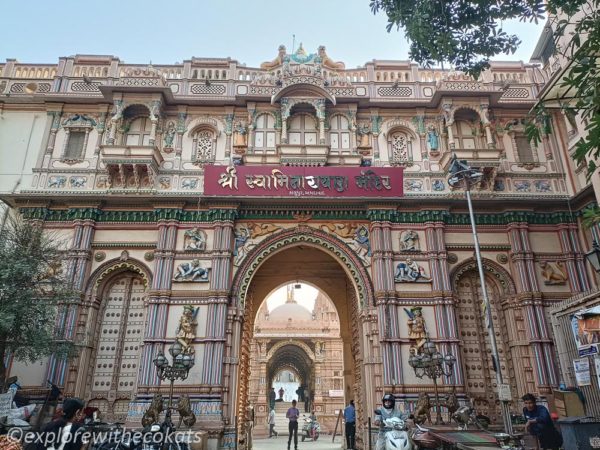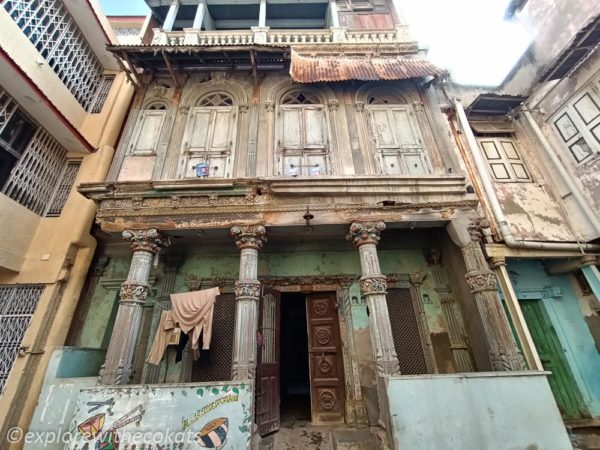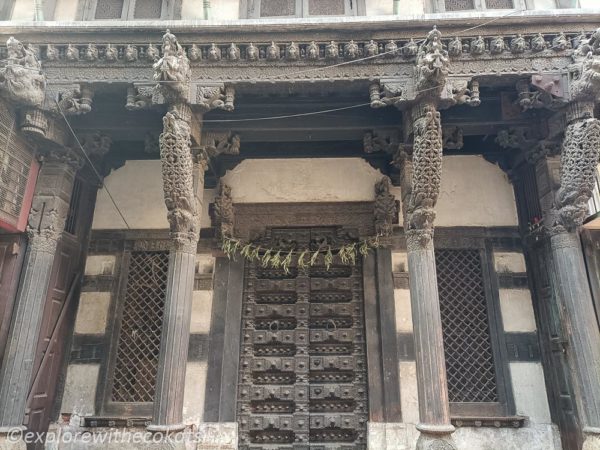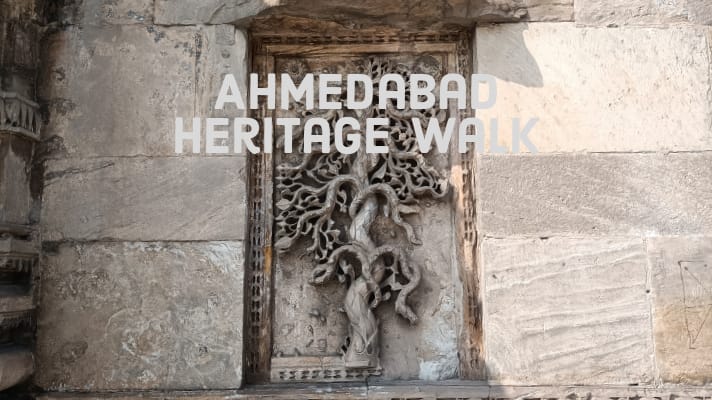Last Updated on February 15, 2022 by
I see and smell similar sights and fragrances as I walk towards Swaminarayan Mandir, the starting point of Ahmedabad heritage Walk. The lanes are already bustling with Fafda joints ready to dish out hot piping breakfast and office goers getting ready for their routine. I pass the newspaper guy on his bicycle and a dhoti clad resident on his way to the temple. This is the Ahmedabad Old city area – always busy, always vibrant.
Table of Contents
About Ahmedabad Heritage Walk
Wondering about things to do in Ahmedabad? Whether you are visiting for a business trip in Ahmedabad or a vacation in Ahmedabad, Ahmedabad Heritage Walk is a must for all locals and visitors.
Ahmedabad Heritage Walk is also known as and advertised as Mandir se Masjid tak for it starts at a temple and ends at a mosque. This walk is a two-kilometre walk held every day. There are a total of 20 sights that includes, Hindu and Jain temples, a mosque, chowks and exquisitely carved bird feeders. The duration of the walk is approximately 2 hours and is a guided tour.
Different types of heritage walks in Ahmedabad
Morning Heritage Walk of Ahmedabad Old city – The walk starts at 7.30 am from Kalupur Swaminarayan temple and ends at Jama Masjid by 10:30 am. It covers 20 heritage spots in 2 km. This is conducted by Ahmedabad Municipal Corporation (AMC).
Night Heritage Walk of Ahmedabad – It starts at 8.45 pm from Sidi Saiyyed Mosque and ends at around 10 pm at Manek Chowk. It covers 16 heritage spots of Ahmedabad in 2 km.
Jain Heritage Walk – It starts at 7 am from Shantinath Derasar and ends at Manek Chowk. It covers 10 Jain Temples, in 2 hours 30 minutes.
Breakfast Heritage Walk by House of MG – It starts at 7.30 am through city highlights, a distance of 1.5 km in 2 hours, and ends with breakfast at House of MG.
Night Heritage Walk by House of MG – It starts at 10 pm from House of MG and ends at Manek Chowk.

Booking / Registering for Heritage Walk Ahmedabad
For the AMC walks, you can book online using this particular link. Alternately, you can mail to [email protected] to reserve your spot. Here are the contact numbers, in case you wish to call and get more details
Toll Free Number – 1800 233 9008
Other numbers – +91 98250 91049, +91 98251 25920
There are two packages available for booking. The luxury package includes a meal while the standard package is just the walk.
For the House of MG heritage walk, you can mail the hotel on [email protected] or call them on +91 79 25506946
Price of a Heritage Walk in Ahmedabad
The AMC heritage walks are charged as below:
Per person – INR 350 for Indian nationals and INR 450 for Foreigners.
The Jain heritage walk is charged INR 500 per person.
Map of Ahmedabad heritage walk

Pols of Ahmedabad
One cannot talk about heritage walks in Ahmedabad and not mention pol. The word Pol is derived from the Sanskrit word Pracholi and over the years of usage, Pracholi became ‘Pol’.
The entire walk is around the pol of the old city of Ahmedabad. While the pol settlement pattern has a rural origin, visitors on the Ahmedabad Heritage Walk can see it live in the urban area of Ahmedabad.
A pol (પોળ) is a housing cluster just like the gated housing societies. Each pol is self-contained with its own community well, a chabutara (bird feeder) and a place of worship. The central chowk of each pol plays the role of a community center – doubling up as a playing space for the kids and a corner for the men, women and elders to catch up daily chit-chat.
There are over 300 pols in the walled city of Ahmedabad. One of the most vibrant pols where a lot of restoration has taken place is Dhal ni Pol.

Ahmedabad Heritage Walk
While the tour officially starts from Shree Swaminarayan Temple, Kalupur we stopped at an offbeat place to reveal in its 500-year-old history and story.
Hasti Bibi no Gokhlo
Very few locals know about this place which is on the main road. It looks like any other small structure on the road, but the vibrant green colour tells a different story.
Hasti Bibi translates to Laughing saint and Gokhlo means a hole. This hole is said to have magical and healing powers. The gokhlo is a simple structure with a marble cavity and a clay lamp resting on a bed of roses and mogra. Whenever a baby wailed due to an illness, the parents would make the child peek in. The laughing saint, a lady would make the crying baby stop and make it smile by putting her hands on the ailing kids.
It is believed that this place is blessed and the air the vibes still carry Hasti Bibi’s healing energy.
Believers with ailing kids still visit here and bow in front of the small hole.

Shree Swaminarayan Mandir, Kalupur
As I walked toward the Kalupur Swaminarayan Temple, I was astounded by the temple gate with sculptures having Rajasthani costumes and all the hawkers leading up to there.
We were assigned our Heritage walk guides and my guide was Esha. One of the astonishing facts she shared was that the temple has never been painted since its original form (over 200 years).
Shree Swaminarayan temple was built in 1822 and is a multi-coloured, wood carved Swaminarayan Temple in Ahmedabad. It was the first temple of the Swaminarayan Hindu sect. It presents idols of Nara Narayana, who occupies the principal seat of the temple, and forms of Arjuna and Krishna at the central altar. The sculptures showcase the cultures and costumes of Maharashtra and Gujarat. The devotees can avail themselves live darshan of the temple here.
The entire complex is pristine with amazing vibes and it is only fair to spend a few minutes in the temple before moving to the next spot.
Read more temple posts here: Aihole ancient temple town, Chidambaram Nataraja Temple, Trimbakeshwar Temple, Mahakuta Temples

Kavi Dalpatram Chowk
After walking a few metres, we reached a chowk, meaning square. A bronze statue sits there peacefully. The statue is that of the famous Gujarati poet and social reformer Dalpatram Dahyabhai who had been affectionately conferred the title of, “Kavishwar.”
He was a famous Gujarati poet who lived between 1820-1998 and stayed in a house in Lambeshwar Ni Pol. in order to pay a tribute to him and his house, a facade has been created that resembles his house. The statue of Kavi Dalpatram sits one leg folded with a book in his lap, a classic rendition of his fondness for kids whom he would invite to sit in his lap and read books to them.

Calico Dome
Calico dome is the original site of Calico Mill, which collapsed in the 2001 earthquake and is being reconstructed. It is the first space-frame structure of India.
Khara Kuva Ni Pol
A few yards away from the Calico dome is the entrance gate to Khara Kuva Ni Pol. The pol gets its name Khara Kuva means ‘saltwater well’ that existed a long time back. Above the entrance gate to the Pol is a room that served as a watchpoint for guards. A door by the side of the entrance leads up to the observation room.
Beyond the gate are houses with architecture from a bygone era – all worthy of documentation.

Kalaram Mandir | Haja Patel Ni Pol
This 400-year-old temple has a presiding deity of Lord Ram. The unique nature of the idol is that it is black in colour. Another unique feature is that instead of Hanuman idol which was his companion and showcased in all Lord Ram temples, this temple contains the idols of his wife Sita and brother Lakshman. That is because this temple is dedicated to the time when he spent years in Vanvas. His idol is in a sitting position and in black colour because of the number of years spent in the forest, his body is full of dust and dirt which is why his statue is in black colour.
The black stone used here is Kasauti stone. This stone is used to determine the purity of gold.
Unlike a temple, this statue actually sits in a home with 15 rooms and is resided by a few families who take up the upkeep of the temple.

Shantinath ni Pol
Just before entering this pol, Esha stopped us at a long pole that had a compass-like structure at the top and asked us to guess what it was. While some of us guessed that it showed the direction to flee in case of an enemy attack, some said otherwise. She informed us that the structure is actually a ventilation pipe that represents the direction in which the sewage pipes in the pol are placed.
We entered a square, which was full of traditional heritage homes. Most of them are made using wood and have intricately carved doors, windows, pillars and brackets. These wooden structures were a saving grace during the 2001 earthquake, as these pol homes did not suffer much damage.

Kuwawalo Khancho
Khancho is a sub-cluster within a Pol, a labyrinth lane. Kuwawalo Khancho is distinctively unique because of architectural influences facing each other. Homes here have colonial arches that reflect British influence while others have Persian brackets. These are classic examples of the integration of harmony of different architectural influences in the dense urban areas of Ahmedabad.
Ashtapadji Deraser
Ahmedabad heritage walk is a gem for a reason and such a gem is the Ashtapadji Derasar (Jain temple) made out of marble. Built-in the 18th century, the temple has idols of Adishwar Bhagwan and Mahavir Swami. It also has many other idols of the guru and their students.
The facade of the Ashtapadji temple is made of three ornate balconies supported by beautiful columns and brackets on the first floor. The ground floor has sculptures and motifs including human figures in dancing positions or playing musical instruments, animals and other floral patterns.

Harkunvar Shethani Ni Haveli
Popular for its exquisite wooden carvings in the facade, the haveli (mansion) is an absolute standout in the busy lanes. The impressive black wooden bracket is impossible to miss as it has elements of Chinese architecture in the form of a dragon. Esha told us that this bracket is the longest bracket within the walled city of Ahmedabad.
The Haveli has 60 rooms that open onto pillared balconies.

Fernandez Bridge
Leading towards Fernandez Bridge are stores selling marriage invitation cards. Also known as Chopda Bazaar (book market), this bridge was built by the British in the early 19th century.
Fernandez Bridge is for Amdavadis what ABC road is for Pune! If you are a student, you wouldn’t have come to Fernandez Bridge for new and used books. From medical books to fiction, from classic to non-fiction, one can find the hottest best-sellers right here!
Fernandez Bridge is a book market that overflows onto the street from its small shops, many of which are hundred years old.
Manek Chowk
While Manek Chowk is popular among the foodies for its Ratri Bazaar (night food market), it is actually a vegetable market in the day that turns its jewellery market around pre-noon and street-food market by night. Talk about metamorphoses in a day!
The chowk has everything in and around it – temples, mosques, food shops, garment shops, souvenir shops, tea stalls, and so much more. One can buy everything they need to live from Manek chowk – safety pins as well as furniture.

Old Ahmedabad Stock Exchange Building
Ahmedabad Stock Exchange building is nothing short of an icon for the business community. This historic building that was over 100 years old saw many transactions before it moved to the swanky new area of Ahmedabad. The Ahmedabad Stock Exchange stopped functioning in the year 2018.

Mahurat Pol
Bang opposite the Stock Exchange building in Manek Chowk is another forgotten place. Mahurat Pol is believed to be the first Pol that was built in the city. The Pol gets its name from the word Mahurat, meaning an auspicious moment. It is also believed that Ahmed Shah I, himself may have lived inside the Mahurat Pol at one time.
It is also believed that in order to start something new – a shop, business transaction or anything, a visit to Mahurat Pol assured the person of an auspicious beginning.
Pols are also present in the old city of Vadodara. Read about: Things to do in Vadodara

Jama Masjid Ahmedabad
The Jama Masjid is a mosque with a reservoir in the centre. The massive proportions of the place reminded me of my recent visit to Delhi. Overlooking a towering overhead light, there are 15 domes and 260 elegant pillars.
Constructed by the founder of Ahmedabad, Ahmed Shah I in the early 14th century, it is a peaceful and quiet area with a huge expanse. People can be seen praying throughout the day.
The exterior of the mosque has elements from Islamic and Gujarat styles of architecture. The sculptures include floral motifs and geometrical patterns on walls and pillars. One of the most striking motifs is of the Kalpavriksha.
This was the last spot in the heritage walk. Visitors can spend more time here or move towards other areas of the city for more heritage.

Which is the best Heritage Walk of Ahmedabad?
I may be biased with my answer but the morning heritage walk conducted by AMC is best according to me. My reasons are:
- The old city is still peaceful with bare minimum traffic so it becomes easy to move around and actually hear what the guide is saying.
- Photographs are also better during the morning light.
- Reasonably priced with knowledgeable guides.
Accommodation in Ahmedabad Old City on Heritage Walk route
Loved the Ahmedabad old city? Want to live in the heritage part of the town? There is a possibility. Many of these pol houses have refurbished themselves into heritage hotels to welcome visitors. Some are also heritage homes.
French Haveli
French Haveli, in the bustling lanes of Dhal ni Pol is a 150-year-old, artistically restored Gujarati heritage home. Being in the old city, visitors are close to all the heritage possible. With 5 comfortable rooms up for grabs, the view to choose from is many. They offer many activities such as cooking, heritage walks and others.
It is possible to book accommodation in French Haveli here.
Jagdip Mehta’s Heritage House
Jagdipbhai is one of the most respected people in Ahmedabad. A family with three generations living under the same roof invites visitors into their heritage home to get a taste of Gujarati culture and food. European influences can be seen on the exterior while the inside is largely in the vernacular Gujarati style.
Reserve rooms in Jagdip Mehta’s Heritage House by calling on +91 9825310315 or email on [email protected]
Sustainable tips for Ahmedabad Heritage Walk
- This is a UNESCO Heritage city, so please respect it in all ways.
- You are walking right outside people’s kitchens, halls and balconies, so be respectful and keep a distance.
- Always ask permission before clicking a picture. They will smile and the photograph will turn out so much better.
- Respect the ancient structures of step wells, temples and mosques by not sitting on them. Use the garden space instead.
- Do not harm the structures by carving or writing on it.
- Do not litter pols with your trash.
Have more days in Ahmedabad? You may want to consider
One day trip to Statue of Unity from Ahmedabad
Weekend destinations from Ahmedabad
Disclosure: I was invited by Gujarat Tourism and the Ministry of Tourism, Government of India to explore Gujarat. However, all opinions in this post are unbiased and of my own. Special thanks to the team for taking take of everything during this trip.
Disclaimer – This post contains affiliate links. It means it adds no extra cost to you if you book through the link but I get a referral bonus which helps me earn a little to keep this website up and running.
Pin this post!


